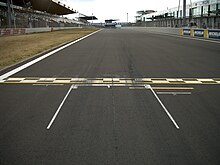Pole position

The pole position or pole position , also called pole [ ˈpəʊ̯l pəˌz ( n ] ( English pole position , pole for pole, post, rod) is the starting position in motorsport in the first row on the so-called starting grid (English grid , in this context for German grid) that is most beneficial for the participants. The pole position is usually achieved before the respective race by qualifying, for example by driving the fastest training or qualification time.
Origin and general usage
The expression itself comes from English horse racing , where the oval racecourse is delimited on the inside with a railing made of wooden poles . If you can start from the square next to this demarcation (i.e. from the pole position ), you have the shorter inner lane to yourself; the other starters have to take a longer outside lane to overtake and are therefore slightly disadvantaged. This pole was also found in early car races, such as in Brooklands , and has remained in motorsport to this day.
The pole position is usually on the cleaner half of the road and allows the pole setter better traction . In earlier times the pole position was fixed in most racing sports (almost always on the inside lane for the first corner), nowadays the pole sitter can mostly choose his own pole .
In the German-speaking world, the term pole setter is used more often , but the term that is more widespread internationally is pole sitter (for pole sitter ). In common parlance, the expression also in a figurative sense stands for an advantage over the competition in a competition for the same thing.
Practical meaning
From the 1950s to the 1970s, Formula 1 started with three or four cars from the front row, depending on the race course, which reduced the advantage of the front row somewhat.
From the 1970s the number of vehicles per row was limited to two, the result of the qualifying became more and more important, which also resulted in a tire and engine race. Due to their center of gravity, some chassis were better off with more gasoline on board than - as would actually be expected - with less fuel.
Until the beginning of the 1990s, tires with special soft rubber compounds were also offered by the manufacturers Goodyear , Pirelli and Michelin , which could "only" be used for a few laps, but were sufficient for a single very fast lap. It was also customary to use special expansion stages of the engines in the qualifying rounds, which could be loaded beyond the speed limit usual in racing , or units that had not yet been sufficiently tested on the test stand, which were replaced by more stable engines for the actual racing use.
In view of the low number of overtaking opportunities on many racing courses in today's motorsport scene, and especially in sprint races over short distances, the pole position is given high priority, as it is often seen as "half the battle" for a possible subsequent victory .
literature
- Jörg-Thomas Födisch / Erich Kahnt: 50 years of Formula 1. The winners , Heel: Schindellegi 1999, 215 pages, ISBN 3-89365-615-4
- Peter Gruner, Das Formel-1-Lexikon , ECON: Düsseldorf 1997, 474 S., ISBN 3-612-26353-6
- Bruce Jones, Formula 1 encyclopedia. Drivers, teams, races and legends, Sportverlag Berlin: Berlin 1999, ISBN 3-328-00848-9
- Fight at the limit. The Formula 1 Chronicle 1950–2000 , ed. v. Willy Knupp, RTL book edition: Zeitgeist Publisher: Düsseldorf / Gütersloh 2000, ISBN 3-89748-277-0
- Ulrich Kühne-Hellmessen (Ed.), Crazy Formula 1. With complete chronicle and super statistics, Sportverlag Europa: Zürich 2004, ISBN 3-9522779-6-7
- Peter Scherer, 50 Years of British Grand Prix Drivers , o. O., 1999, 233 p., ISBN 0-9530052-8-3
- Achim Schlang, The Formula 1 aces of our time , Motorbuch Verlag: Stuttgart 1984, 213 S., ISBN 3-613-01035-6
- Koen Vergeer, Formula 1. History of a fanatic love, Rütten & Loening: Berlin 2001, 270 pages, ISBN 3-352-00638-5
Individual evidence
- ↑ DMSB-Automobil-Rundstreckenreglement 2013, page 2 (PDF file; 1.52 MB), accessed from the German Motor Sport Association on February 3, 2013.